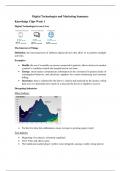Summary
Digital Technologies and Marketing Summary (Lectures, Readings, Q&As), Grade 8,5/10Grade
- Course
- Institution
PM for DISCOUNT :) Following this summary, which includes all lecture slides / notes, book notes, and Q&A lectures helped me achieve an 8,5 grade in my final examination. The summary is pretty recent, so do not hesitate to check it out! Good luck on your exams. Please leave a positive rating ...
[Show more]




